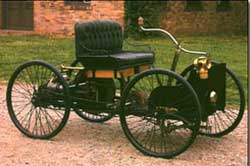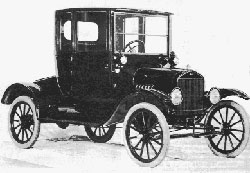Henry Ford: Difference between revisions
No edit summary |
m (Text replace - "[[Category:Power, energy & industry application|" to "[[Category:Power, energy & industry applications|") |
||
| Line 31: | Line 31: | ||
<p>After his death, Ford's stock holdings went to the Ford Foundation, which had been set up in 1936 as a means of retaining family control of the firm. The Ford Foundation has subsequently became one of the richest private foundations in the world. </p> | <p>After his death, Ford's stock holdings went to the Ford Foundation, which had been set up in 1936 as a means of retaining family control of the firm. The Ford Foundation has subsequently became one of the richest private foundations in the world. </p> | ||
[[Category:People and organizations|Ford]] [[Category:Corporations|Ford]] [[Category:Transportation|Ford]] [[Category:Automotive engineering|Ford]] [[Category:Power, energy & industry | [[Category:People and organizations|Ford]] [[Category:Corporations|Ford]] [[Category:Transportation|Ford]] [[Category:Automotive engineering|Ford]] [[Category:Power, energy & industry applications|Ford]] [[Category:Engines|Ford]] [[Category:Internal combustion engines|Ford]] [[Category:Vehicles|Ford]] [[Category:Road vehicles|Ford]] | ||
Revision as of 13:49, 13 November 2013
Biography
Born: July 30, 1863
Died: April 7, 1947
Henry Ford did not invent the automobile, but he did masterfully develop the methods that made mass-production of automobiles possible. He is perhaps the person most responsible for launching the “car culture” in the United States.
Ford was born in Dearborn, Michigan, the son of Irish immigrants who fled the potato famine in the 1840s. As a child Ford attended a one-room school for eight years and helped his father work the family farm. At age 16, the industrious Ford walked to Detroit to find work in its machine shops. It was in these shops that he had his first contact with the internal combustion engine. In internal combustion engines, the engine produces power by sucking in a mixture of gasoline and air and igniting it with a spark. The force of this explosion provides power to operate a vehicle or other machine.
Ford married Clara Bryant in 1888 and five years later welcomed their only child, son Edsel. In 1891 Ford became an engineer at the Edison Illuminating Company in Detroit. Within just a couple of years he was promoted to Chief Engineer. This promotion gave him enough time and money to conduct his own experiments on internal combustion engines. By the end of 1893 he had built his first working gasoline engine. Three years later he constructed his first horseless carriage, the Quadricycle. It was a four-horsepower vehicle with the chassis of a buggy frame mounted on four bicycle tires.
Ford dreamed of manufacturing automobiles, but his first two attempts at establishing a company failed. Financial backers pressured him to release a passenger automobile, but Ford insisted on waiting. Finally, in 1903, Ford was ready to market an automobile. The Ford Motor Company was incorporated with a mere $28,000 in cash put up by ordinary citizens, because Ford had already antagonized the wealthiest men in Detroit.
Ford’s idea of mass-producing a car affordable enough for the average worker met with resistance from the automobile industry. Nevertheless, Ford stuck to his goal, beginning production of the Model T in 1908. He gradually adapted the production line and in 1913 his plant incorporated the first moving assembly line, allowing for greater production. Demand for the affordable car soared; by 1927, fifteen million had been sold, and Ford was the leading auto manufacturer in the country. In addition to the moving assembly line, Ford revolutionized the auto industry by increasing the pay and decreasing the hours of his employees. During the Model T era, Ford bought out his shareholders so he had complete financial control of the now vast corporation. He continued to innovate, but competitors, growing more powerful though fewer in number, began to cut into Ford's market share.
The unprecedented scale of his competitor’s success, together with Ford's absolute control of the firm, set the stage for decline. Trusting in what he believed was an unerring market instinct, Ford refused to follow other automobile manufacturers in offering innovative features. When he was finally convinced that the marketplace had changed and was demanding more than a purely utilitarian vehicle, he shut down his plants for five months to retool. In December 1927, he introduced the Model A. The new model enjoyed solid, but not impressive, success. Ford's stubbornness had cost him his leadership position in the industry: the Model A was outsold by General Motors's Chevrolet and Chrysler's Plymouth and was discontinued in 1931.
A similar pattern of inflexibility and stubbornness marked Ford's attitude toward his workers. The $5 day that brought him so much attention in 1914 came at the cost of workers’ individualism and independence. It was, moreover, no guarantee for the future. In 1929 Ford instituted a $7 day, but in 1932, as part of the fiscal stringency imposed by falling sales and the Great Depression, that was cut to $4, below standard industry wages. Ford used company police, labor spies, and violence in a protracted effort to prevent unionization. He continued to do so even after General Motors and Chrysler came to terms with the United Automobile Workers. When the UAW finally succeeded in organizing Ford workers in 1941, he considered shutting down before he was persuaded to sign a union contract.
Henry Ford was an idiosyncratic and complex personality. Away from the shop floor he exhibited a variety of enthusiasms and prejudices. His dictum that "history is more or less bunk" was widely known. One of Ford's most publicized acts was his chartering of an ocean liner to conduct himself and a party of pacifists to Europe in November 1915 in an attempt to end the war by means of "continuous mediation." The so-called Peace Ship episode was widely ridiculed. In 1918, with the support of President Woodrow Wilson, Ford ran for the U.S. Senate. He was narrowly defeated after a campaign of personal attacks by his opponent and never ran for office again. Also in 1918, Ford bought The Dearborn Independent newspaper and used it to publish a series of anti-Semitic attacks. In 1927 he formally retracted his attacks and sold the paper. He expressed admiration for Adolf Hitler in the 1930s.
On the other hand, Henry Ford was also recognized for several civic contributions: he established small village factories; built one-room schools in which vocational training was emphasized; experimented with soybeans for food and durable goods; sponsored a weekly radio hour on which quaint essays were read to "plain folks"; and constructed Greenfield Village, a restored rural town. He also built what later was named the Henry Ford Museum and filled it with American artifacts and antiques from the era of his youth. In the 1920s, Ford decided to move his hero and friend Thomas Edison’s Menlo Park invention factory to the museum. He and Edison went to New Jersey to recover the buildings but found that most had been removed or were in disrepair. Ford then had his staff reconstruct the Menlo Park buildings from photographs and a few surviving original materials. Today the Henry Ford Museum & Greenfield Village houses a vast collection of Edison artifacts.
After his death, Ford's stock holdings went to the Ford Foundation, which had been set up in 1936 as a means of retaining family control of the firm. The Ford Foundation has subsequently became one of the richest private foundations in the world.


